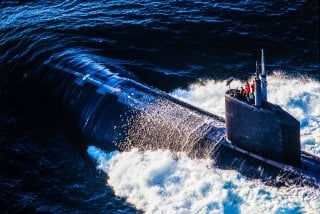Canada's Submarine Crisis Will Constrain Its Arctic Ambitions
The new submarines for Canada’s Arctic strategy are specifically designed to stay under the ice for protracted periods. Meanwhile, the first submarines are to be deployed by the mid-2030s, around the same time that the Victoria-class subs are set to be decommissioned.
Canada finds itself in a sticky geopolitical situation. The incoming Trump administration seems to believe that it is going to at some point annex Canada. Meanwhile, the Russians are breathing down Canada’s neck in the Arctic, with the Russian military challenging Canada for dominance over key strategic points in the High North.
Ottawa also faces a territorial dispute with Washington over portions of the Northwest Passage, which is quickly evolving into a key strategic waterway.
To better combat these threats, the Canadian government has announced its intention to build twelve nuclear-powered submarines that will be dedicated to securing Canada’s vast interests in the Arctic. There’s only a small problem: Most experts I have spoken with are skeptical that the Canadian bid to build twelve Air-Independent Propulsion (AIP) submarines will ever happen. And, even if it does, it is unlikely to occur in any meaningful timeframe.
Our North, Strong and Free?
Ottawa is calling the program “Our North, Strong and Free,” and it is billed as a comprehensive strategy of deterrence. But Canada’s problems are much deeper than just being unable to field submarines.
Currently, Canada's navy is in shambles. Last summer, for instance, a Canadian warship dispatched to the U.S.-organized RIMPAC military exercises at Hawaii had been sidelined from the Pacific exercise due to a major cooling water leak onboard. In fact, multiple headlines have proliferated since last summer about the massive flooding problems with Canada’s warships. What happened in Hawaii was not an isolated incident.
That’s to say nothing of the personnel crisis affecting the Canadian Navy. Basically, Canada’s navy is not attracting talent in any meaningful way. Canada’s military is, therefore, withering both in terms of platforms and personnel.
Oh, and the Canadian submarine force is especially laughable. Currently, the Royal Canadian Navy operates just four Victoria-class diesel-electric submarines. When these subs aren’t being repaired in port, they are deployed to distant locations in the Pacific, taking them far away from the far more important (for Canada, at least) strategic zone of the Arctic.
That’s part of the reason behind the Canadian investment in the twelve new AIP-breathing submarines.
The new submarines for Canada’s Arctic strategy are specifically designed to stay under the ice for protracted periods. Meanwhile, the first submarines are to be deployed by the mid-2030s, around the same time that the Victoria-class subs are set to be decommissioned. Yet, given the aforementioned problems with Canada’s defense industrial base, the likelihood that this program will ever get moving beyond the conceptual phase—or that the twelve submarines will be built—is very low.
Real Problems
And the longer the Canadians wait, the greater the chance they will lose their claim on the Arctic—if not officially, then unofficially—as both the Russians and Americans move to dominate the region.
At the same time, there are so many structural issues within Canada’s defense industrial base as well as its overall defense community that the idea the country could ever muster a real challenge to a true near-peer rival, such as China, is laughable.
Bottom line: the Canadian Navy is broken. It will not be repaired any time soon. Expect more, not fewer, egregious problems as the Canadian Royal Navy continues its downward spiral.
Brandon J. Weichert, a Senior National Security Editor at The National Interest as well as a Senior Fellow at the Center for the National Interest, and a contributor at Popular Mechanics, consults regularly with various government institutions and private organizations on geopolitical issues. Weichert’s writings have appeared in multiple publications, including the Washington Times, National Review, The American Spectator, MSN, the Asia Times, and countless others. His books include Winning Space: How America Remains a Superpower, Biohacked: China’s Race to Control Life, and The Shadow War: Iran’s Quest for Supremacy. His newest book, A Disaster of Our Own Making: How the West Lost Ukraine is available for purchase wherever books are sold. He can be followed via Twitter @WeTheBrandon.
Image: Shutterstock.

